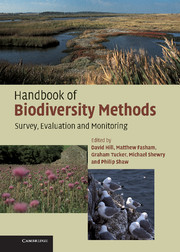Book contents
- Frontmatter
- Contents
- Preface
- Acknowledgements
- Part I Planning
- 1 Introduction to planning
- 2 Planning a programme
- 3 Biodiversity evaluation methods
- Part II Habitats
- Part III Species
- Appendix 1 Monitoring and reporting obligations under international conservation agreements
- Appendix 2 Relationship between BAP Priority Habitat and Broad Habitat categories and Habitats Directive nomenclature
- Appendix 3 Annotated list of key references for plant identification
- Appendix 4 Determining appropriate quadrat size for vegetation sampling
- Appendix 5 The relocation of permanent plots
- Appendix 6 Equipment required for undertaking different types of survey
- Recommended sources of further information
- References
- Glossary
- Index
1 - Introduction to planning
Published online by Cambridge University Press: 01 September 2010
- Frontmatter
- Contents
- Preface
- Acknowledgements
- Part I Planning
- 1 Introduction to planning
- 2 Planning a programme
- 3 Biodiversity evaluation methods
- Part II Habitats
- Part III Species
- Appendix 1 Monitoring and reporting obligations under international conservation agreements
- Appendix 2 Relationship between BAP Priority Habitat and Broad Habitat categories and Habitats Directive nomenclature
- Appendix 3 Annotated list of key references for plant identification
- Appendix 4 Determining appropriate quadrat size for vegetation sampling
- Appendix 5 The relocation of permanent plots
- Appendix 6 Equipment required for undertaking different types of survey
- Recommended sources of further information
- References
- Glossary
- Index
Summary
THE PURPOSE OF SURVEYING AND MONITORING
The development of a successful programme is dependent upon being clear about what you want to do and why, i.e. your objectives. It is therefore important to define what monitoring is and how surveys relate to monitoring. Survey and monitoring is undertaken for a wide range of objectives: for example, to measure a site's quality, or a species' abundance, to assess species and habitat trends, for Environmental Impact Assessment (EIA) studies, for corporate reporting, or to assess compliance with international conservation agreements. These operate at many different spatial scales and therefore necessitate targeted methods for different applications, objectives and deliverables. The significance and global importance of monitoring nature conservation is aptly summarised in Appendix 1, which describes the monitoring and reporting obligations under international conservation agreements as an example of the far-reaching implications of the need to use adequate methods.
General objectives of surveying and monitoring
For the purposes of Environmental Impact Assessment (EIA) studies, the term ‘survey’ defines the collection of spatial and/or temporal data about a species, a community or a habitat. The information provides a snapshot of presence, absence and, dependent on its design and sophistication, abundance and spatial distribution. In EIA studies the survey data are used to evaluate the ecological resource on a site, which is then assessed or evaluated against set agreed criteria. Impacts are considered in respect of this resource and assessed for significance.
- Type
- Chapter
- Information
- Handbook of Biodiversity MethodsSurvey, Evaluation and Monitoring, pp. 3 - 5Publisher: Cambridge University PressPrint publication year: 2005
- 2
- Cited by



